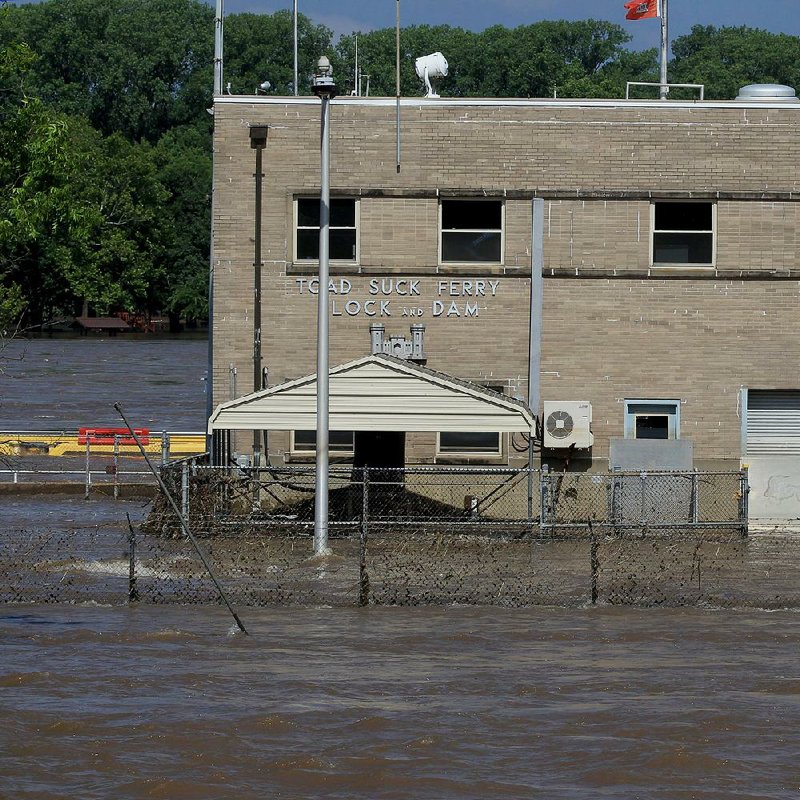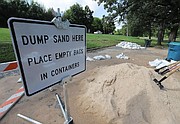With water receding along parts of the Arkansas River, the task turns to assessing the damage, cleaning up the property and figuring out how to pay for it.
President Donald Trump on Saturday approved Gov. Asa Hutchinson's request for more than $27 million to meet the housing needs of Arkansans across eight flooded counties.
Hutchinson submitted a federal disaster declaration to Trump on Friday, indicating that floodwaters had destroyed or caused major damage to at least 857 homes in those eight counties, though that number is expected to rise.
Arkansas Insurance Commissioner Allen Kerr said residents affected by the historic flooding should begin the insurance process now.
"You don't have to wait for water to go down to apply for an insurance claim," Kerr said. "You need to be filing those now so you can get in the queue. You don't want an adjuster to have to wait to see you till the end of August."
Kerr said even if a resident doesn't have flood insurance, it's important to file a claim on the damage.
The water finally crested Friday in the southeastern part of the state.
Kerr said one of the first things the Federal Emergency Management Agency commonly requires is a declaration of coverage from a homeowners policy. Even people who have flood insurance should file claims on their regular homeowners insurance, he said.
"The whole purpose is to exhaust all other avenues of coverage, so when you go into FEMA you have what you need for assistance," Kerr said. "It's always best to go ahead and call an agent and turn in a claim so an adjuster will do the research."
Many homeowners, if they purchase flood insurance at all, buy the minimum that's required for their mortgages, Kerr said. Only 5% of people in Arkansas who live in flood-prone areas have flood insurance, Kerr said.
Most minimum-level flood insurance policies cover the structure, not the building's contents, he said. When filing a claim, a policyholder should include everything in the building that's damaged -- furniture, belongings, equipment -- not just the structure, Kerr said.
Robin Smith, a spokesman for FEMA's Region Six, which includes Arkansas, said Saturday that taking photos of everything damaged by water can help support claims for FEMA and for other avenues of disaster relief.
"Take pictures, pictures, pictures," Smith said. "When you're doing the water-depth lines, find some way to shoot a picture not just of a close-up on the line, but where it's got something for perspective. Stand in the middle of each room in your house and take pictures from every angle, and once you've done that, start opening your drawers and cabinets. ... The more that you can prove, the more they may be able to help you."
Some residents in Northwest Arkansas, where the river level has gone down, may have already begun mucking out their homes, she said. For those people, Smith recommended taking photos of the damaged furniture and belongings that have been removed from the homes or documenting and cataloging everything in the piles.
"You've probably pitched out things you haven't even thought about," she said.
Melody Daniel, spokesman for the state's Emergency Management Department, advised that once residents have documented the damage, they should not touch anything that has been affected by floodwaters unless they are wearing gloves, eye protection and boots.
Also, "please check with your local jurisdiction for sandbag disposal," Daniel said. "Contaminated sandbags should be handled with caution."
FEMA's Smith said that when cleaning up and filing claims, residents should consider not just items and parts of the home that were submerged, but also parts of the structure into which water might have seeped.
"If your Sheetrock got wet, the water probably wicked up into the insulation," Smith said. "You've got to let that stuff dry out, otherwise you're making a mold farm. ... Most people have insulation between the floor and ground. If the water even touched the insulation, that insulation is now wet."
When FEMA begins to set up disaster recovery centers, Smith said there will always be representatives from other organizations there to try to match claimants with the available aid that fits their situation.
U.S. Rep. Bruce Westerman, R-Ark., said FEMA money is primarily intended to cover costs not covered by flood insurance, and that people with flood insurance who receive Individuals and Households Program grants must repay the money once they are reimbursed by insurance companies.
While the federal aid will certainly help residents, they should consider FEMA a small part of the recovery process, Smith said.
The average amount from FEMA after a disaster is less that $6,000, she said. "We're more like a life vest than a lifeboat. We truly are the thing that's going to keep your head above water. Local state agencies, insurance, local nonprofits, they're going to be your lifeboat."
The first step for flood victims, however, is identifying and documenting losses as much as possible and beginning to file insurance claims.
"Right now, we're in the very early stages of this," Smith said. "Go, talk to your insurance agents, photograph or write down everything you can. We won't know you have damage unless you tell us you have damage."
Metro on 06/09/2019

